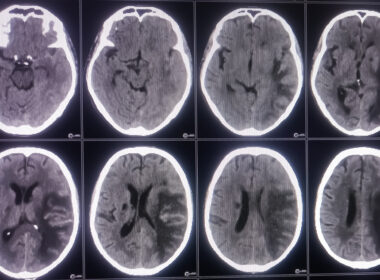Erb’s palsy, also called Erb Duchenne Palsy, is characterized by arm weakness and loss of voluntary movement. The condition is not restricted to children, it can also affect adults.
The brachial plexus is commonly injured due to direct downward force on the upper arm and shoulder or intra-delivery trauma.
The shoulder, arm, hand, and fingers are all connected to the rest of the body via the brachial plexus of nerves in the upper back and chest. The nerve injury can affect the growth and development of the shoulder.
A stretch injury that damages some nerve fibers may result in scar tissue. The scar tissue may press on the remaining healthy nerves leading to a medical condition called a neuroma.
Erb’s Palsy (Brachial Plexus Birth Palsy)
Erb’s palsies are forms of brachial plexus palsy. It was initially named after Wilhelm Erb, the first medical professional to describe the condition. The brachial plexus is a network of nerves in the arm connecting all the nerves in the neck area.
Palsy is a medical condition that can lead to arm weakness or loss of mobility in the affected arm. This nerve carries impulses to the shoulders, arms, and fingers.
What is Erb’s Palsy in Infants?
Erb’s palsy can be caused in infants by injuries to skeletal muscle. This sometimes occurs in infants due to nerve injuries during childbirth. It is also sometimes called brachial plexus palsy, named after the bundle of nerves damaged.
Signs and Symptoms of Erb’s Palsy
Typical Erb’s Palsy symptoms include:
- Lack of reflexes on the affected sidearm;
- partial or total loss of arm movement;
- Minimal grip strength in the affected hand;
- Weakness in one arm.
If doctors don’t detect the condition earlier, the child may develop weakness, loss of sensitivity, and partial or total paralysis in the arm. Legal and professional medical advice is strongly recommended to help determine the cause and extent of your child’s injury.
Erb’s Palsy Prognosis
An Erb palsy diagnosis indicates the predicted prognosis for this condition. Fortunately, overall outlooks are generally good in brachial plexus palsy. When the diagnosis is made, The prognosis will be explained by a medical expert in detail for the following possible action.
Erb’s palsy can affect any age group, but it is diagnosed through a physical examination of the arms. Some healthcare professionals use the latest cutting-edge techniques to increase the prognosis and monitor the progression of the disease.
With appropriate prompt treatment, milder cases have a higher recovery rate, and patients often return to their normal daily activities quickly. Sometimes patients can be completely healed by medical treatments such as surgery and therapy.
How is Erb’s Palsy Diagnosed?
The most common Diagnostic procedures include:
- Electromyogram (EMG): In response to stimulation, this test measures the nature and speed with which electrical impulses travel along a nerve and the electrical activity of a muscle. It can detect and measure the extent of nerve damage.
- Imaging studies: The doctor may recommend an imaging test (such as an X-ray, ultrasound, or MRI) to look for shoulder and neck damage.
- Nerve conduction studies: Each nerve’s ability to conduct an electrical signal from the brain to the muscles are evaluated. A shock-emitting and recording electrodes are placed directly over the nerves and muscles of interest. Repeated, brief electrical pulses are sent from the shock-emitting electrode to the nerve, and the time it takes for the power to contract in response to the electrical pulse is recorded by the recording electrode.
Types of Injuries to the Brachial Plexus
The severity of the symptoms seen in a child with Erb’s palsy depends on the injury to the brachial plexus. The common types of brachial plexus injury include:
- Neurapraxia: It is the most common form of damage. This indicates that the nerves have been shocked but not torn or damaged after being stretched to their limits. In most cases, infants will feel better within three months.
- Neuroma: When nerves are stretched beyond their limits, it can lead to a condition known as neuroma. As a result, scar tissue may form and put pressure on healthy nerves. Although it may take longer for infants with neuromas to get better, most infants finally recover entirely.
- Rupture: A rupture occurs when multiple nerves are torn and unable to mend independently.
- Avulsions: They are the most severe form of brachial plexus injury. Ruptures and avulsions are severe injuries. The spinal cord and nerves have torn apart. Surgery might help.
Causes of Erb’s Palsy
An involuntary downward force on the shoulder can cause Erb’s palsy or lateral hyperextension of the baby’s neck during a difficult delivery.
Damage to the brachial plexus nerves can also lead to Erb’s palsy. It’s common during labor and delivery. Your shoulder and arm may be paralyzed. Infants with this condition often get better without treatment.
When a baby is bigger than average s, delivery can be challenging, and the baby may develop Erb’s palsy. This can happen if the mother has poorly controlled diabetes or her pregnancy is complicated by diabetes.
Erb’s palsy can also develop in older people if they have a severe injury to their shoulder through a slip, fall, or accident.
Legal Assistance for Erb’s Palsy
Most Erb’s palsy results from medical mistakes during pregnancy. Doctors and other healthcare providers can cause severe injuries to the brachial plexus during childbirth.
Compensation from a court settlement is a way to pay for Erb’s palsy care and hope the patient recovers entirely. It is advisable to get prompt legal assistance from a medical malpractice attorney immediately after the medical negligence.
Can Erb’s Palsy Be Cured?
Erb’s palsy resolves in the first year of life in 80% to 96% of patients. Nerve surgery is not done until the infant is six months old. Contact a birth injury lawyer immediately if your child has Erb’s palsy. They can determine if the condition qualifies as a medical malpractice claim.
What Muscles Are Paralyzed in Erb’s Palsy?
Erb’s palsy, also known as Duchenne-Erb paralysis, affects the C5 and C6 roots of the brachial plexus. The deltoid, biceps, brachialis, infraspinatus, supraspinatus, and serratus anterior muscles are all weakened by C5 and C6 palsy. Erb’s palsy can also severely affect the rhomboids, levator scapulae, and supinator muscles.
Is Erb’s Palsy a Birth Defect?
According to research, Brachial plexus birth injury is an injury to the brachial plexus nerves that occurs in about 1 to 3 per 1000 live births. During a difficult delivery, the brachial plexus nerves may be stretched, compressed, or torn.
If you have Erb’s palsy, your shoulder and arm may feel weak or even paralyzed. Erb’s palsy results from nerve damage sustained during labor and delivery, which can result from substandard medical care.
Many factors can lead to obstetric brachial plexus palsy, some involving the doctor or other medical professional manipulating the baby so that the brachial plexus nerves are stretched and damaged. Only about one percent of cases of Erb’s palsy occur during cesarean section births.
Do Babies Recover From Erb’s Palsy?
Although most babies fully recover within the first three months, some may experience loss of function in their affected arm; most kids heal entirely or with only mild impairment with the help of physical therapy.
Is Erb’s Palsy a Neurological Condition?
Erb palsy (also known as Erb-Duchenne paralysis) remains one of the most prevalent neurological birth injuries due to medical instrument mishaps during delivery and severe infant complications.
The ventral rami of cervical nerves 5–8 and thoracic nerve 1 combine to form the brachial plexus, which can be damaged. All upper-body muscles except the trapezius are innervated by the brachial plexus leading to prominent symptoms in upper body functions and mobility.
Is Erb’s Palsy a Disability?
Erb’s Palsy is a physical impairment that primarily affects the muscles and nerves of the upper body. No disease or congenital disability can be blamed for this impairment.
It’s often caused by traumatic injury, either congenitally, later in life or medical malpractice.
Does Erb’s Palsy Affect the Brain?
Erb’s palsy damages the brachial plexus, a group of nerves that support the shoulder.
Erb’s palsy differs from cerebral palsy because it is not caused by damage to or abnormalities in the brain. Erb’s Palsy can also be called Brachial palsy, Erb-Duchenne paralysis, or Klumpke paralysis.
How Do I Know If My Baby Has Nerve Damage?
One or more of the following symptoms may be present if your child suffers from a nerve injury or damage:
- Numbness;
- Prickly or tingling feelings;
- Inability to sense and respond to physical contact.
Can Erb’s Palsy Get Worse?
Erb’s Palsy is characterized by arm weakness or numbness and, in severe cases, paralysis and nerve damage. Temporary paralysis is more common than permanent paralysis. In the absence of treatment, symptoms will likely worsen and persist indefinitely.
What’s the Difference Between Cerebral Palsy and Erb’s Palsy?
In contrast to cerebral palsy, Erb’s palsy is caused by damage to neck nerves, whereas cerebral palsy is caused by damage to the brain. Erb’s palsy also differs from other brachial plexus injuries, such as Klumpke’s palsy, which is uncommon in babies and causes paralysis of the lower brachial plexus, affecting hand muscles.
How Prevalent Is Erb’s Palsy?
Recent data reveals that his condition affects 1-2 out of every 1,000 newborns. This condition can develop due to lateral hyperextension of the baby’s neck during a difficult delivery. With daily physical therapy exercises, most infants with brachial plexus birth palsy will regain movement and feeling in the affected arm.
Which Newborn Is Most at Risk for Brachial Plexus Injury?
Breech births, births of larger-than-average babies, and long and arduous labors are the risk groups for brachial plexus injury.
Physiotherapy Management in Erb’s Palsy
During the first six months, treatment is explicitly directed at preventing permanent deformities. Physiotherapy should be performed daily to maintain ROM( range of motion) and improve muscle strength.
Can a Baby Be Born With Nerve Damage?
A baby may be born with paralysis or other disabilities related to the damaged nerve or nerves. Injuries to the facial nerves are more common due to complications of forceps delivery and increased subsection to compression during childbirth.
What Is the Risk of Long-Term Injury to the Brachial Plexus?
Brachial plexus injuries can have serious long-term consequences, such as impairments in balance, coordination, stamina, strength, limb length discrepancies, bone growth, and joint dysfunction.
What Does an MRI of the Brachial Plexus Show?
An MRI of the brachial plexus can show acute inflammatory demyelinating processes of the brachial plexus or cauda equina manifest on magnetic resonance imaging; it can also show the diffuse thickening and enhancement of the proximal nerve roots.
How Do I Know if Nerve Damage Is Healing?
The muscles innervated by the damaged nerve may feel uncomfortable and tingly as the nerve heals. This could be accompanied by a tingling or electric-shock-like feeling at the level of the new nerve fibers, which should disappear as the nerve repairs and grows.
What Are the Most Common Neurological Disorders in Infants?
Newborns may experience a wide variety of neurological disorders, including:
- Seizures/epilepsy;
- Neonatal encephalopathy;
- Abnormal muscle tone;
- Neural tube defects;
- Periventricular leukomalacia (PVL);
- Intraventricular hemorrhage (IVH).
Does My Child Need an Erb’s Palsy Splint?
A splint can help treat this condition by restoring mobility and strengthening weak muscles. Slings for Erb’s palsy come in various forms and styles, each serving a specific purpose in treating the disease.
How Do You Know if Your Baby Has Neurological Issues?
Warning signs of a neurological disorder include:
- Abnormal muscle tone at birth;
- Seizures;
- Floppy baby;
- Subtle staring/unresponsive episodes.
What Are Abnormal Movements in Babies?
Many non-epileptic motor abnormalities can be found in newborns; other abnormal movements, such as neonatal hyperekplexia, are seen less frequently than tremors, jitteriness, and benign neonatal sleep myoclonus. A healthcare professional can give a detailed explanation of the implication of the abnormality present.
Treatments and Management of Erb’s Palsy
While some cases of Erb’s palsy may require surgery, others may respond well to physiotherapy alone.
.Passive and active range of motion exercises are recommended after an initial period of immobilization. Erb Palsy can be treated in a variety of ways which include:
- Hydrotherapy: Hydrotherapy can be used to alleviate the symptoms of Erb’s palsy. Erb’s palsy patients often benefit from hydrotherapy as a form of physical rehabilitation. When a baby is placed in an anti-gravity environment, the doctor can do their procedures without putting unnecessary strain on the infant’s body. Muscles can be strengthened, and the damaged area can be used without triggering spasms.
The American Cancer Society (ACS) recommends hydrotherapy for specific injuries, but few people know it. In addition to assisting in the recovery from Erb’s palsy, hydrotherapy can also help alleviate your child’s suffering. - Physiotherapy: Some patients will respond to the treatment more quickly than others. Physical therapy can help strengthen rehabilitation and post-surgical recovery. Gentle stretching, sensory stimulation, range of motion, and strength exercises are all examples of possible physical therapy exercises.
- Occupational therapy: After surgery or for those who have sustained permanent damage, occupational therapy may be necessary to help with daily tasks like eating, tying shoes, playing, drawing, etc.
- Surgery: Surgery is typically put on hold until it is determined that non-invasive treatment options, such as physical therapy, have failed to improve the patient’s functional capability. Nerve grafting and nerve decompression are the most common forms of nerve damage surgery. Nerve grafting has the highest success rate.
- Injections: Botulinum toxin injections are sometimes used to relieve contractures.
Compensation from a legal settlement can help you pay for your child Erb’s palsy treatment in hopes that they’ll fully recover. If you believe your child’s Erb’s palsy stems from medical negligence during birth, get a free case review to learn more about your right to compensation.








